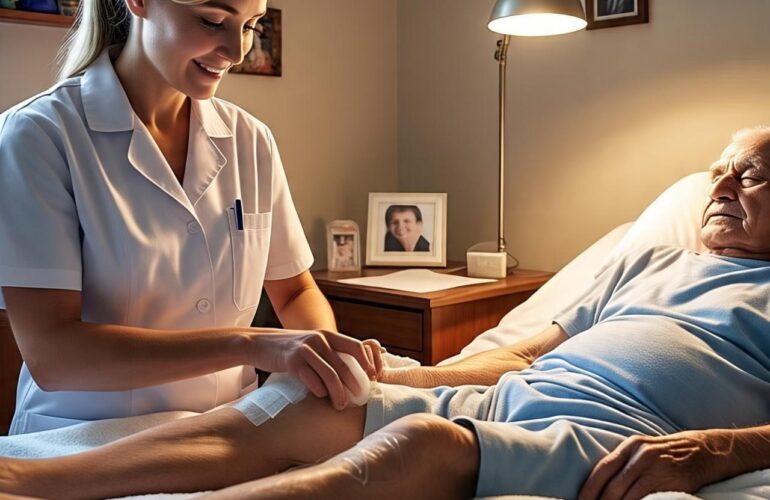Wounds are a part of life. Whether it’s a small cut, a scrape, a burn, or a surgical incision, knowing how to care for a wound at home is essential. Proper wound care helps prevent infection, speeds up healing, and reduces the chances of scarring or complications. This blog explains how to manage wounds at home using safe and simple methods.
TYPES OF WOUNDS
Before treating a wound, it’s helpful to understand what kind it is. Here are some common types of wounds:
- Abrasions – Abrasions is Caused by skin rubbing against a rough surface. Common in falls.
- Lacerations – Deep cuts or tears in the skin, often caused by sharp objects.
- Punctures – Small holes made by things like nails or needles.
- Burns – Caused by heat, chemicals, electricity, or the sun.
- Incisions – Clean cuts made by sharp instruments, usually during surgeries.
Each type may need a slightly different approach, but basic care principles remain the same.
FIRST AID STEPS FOR MINOR WOUNDS
Follow these steps to clean and dress a wound at home:
1. Wash Your Hands
Always clean your hands with soap and water or use hand sanitizer before touching a wound. This prevents bacteria from entering the injury.
2. Stop the Bleeding
Use a clean cloth or bandage and apply gentle pressure to the wound. Most small wounds stop bleeding within a few minutes. If it doesn’t stop after 10 minutes, seek medical help.
3. Clean the Wound
Use clean water to gently rinse the area. Avoid using hydrogen peroxide or iodine directly on open wounds—they can damage tissues. You can use mild soap around (but not inside) the wound.
4. Remove Dirt and Debris
Check for tiny stones or dirt. Use sterilized tweezers to remove them carefully. If debris remains, go to a doctor to prevent infection.
5. Apply an Antibiotic Ointment
After cleaning, apply a thin layer of over-the-counter antibiotic ointment like Neosporin. This helps prevent infection and keeps the wound moist, which promotes faster healing.
6. Cover the Wound
Use a sterile bandage or gauze to cover the wound. This protects it from bacteria and dirt. Change the dressing daily or whenever it gets wet or dirty.
WHEN TO SEEK MEDICAL ATTENTION
While many wounds can be managed at home, some need professional care. See a doctor if:
- The wound is deep or longer than 1 inch.
- It continues to bleed even after applying pressure.
- There’s a risk of tetanus (e.g., puncture from a rusty nail).
- Signs of infection appear (redness, swelling, pus, warmth, or fever).
- You haven’t had a tetanus shot in the past 5–10 years.
- A foreign object is stuck and can’t be removed.
DAILY WOUND CARE TIPS
- Keep It Clean and Dry: Clean the wound every day and keep it covered. Change the bandage regularly.
- Don’t Pick Scabs: Let scabs form and fall off naturally. Picking can cause scars or infections.
- Watch for Signs of Infection: If the wound gets redder, painful, or starts oozing, consult a healthcare provider.
- Elevate the Wound: If it’s on a leg or arm, keep it raised to reduce swelling.
- Eat Healthy: A diet rich in protein, vitamin C, and zinc helps wounds heal faster.
- Avoid Smoking and Alcohol: They slow down the healing process.
NATURAL REMEDIES FOR MINOR WOUNDS
Many households use natural ingredients for minor wound care. While these are not substitutes for medical treatment, they can be helpful:
- Honey: Has natural antibacterial properties.
- Aloe Vera: Soothes the skin and helps heal burns and cuts.
- Turmeric: Known for its anti-inflammatory and antibacterial effects.
- Coconut Oil: Moisturizes and may prevent infection.
Always test a small area first to ensure you don’t have an allergic reaction. Avoid applying anything directly into deep or serious wounds.
COMMON MISTAKES TO AVOID
- Using Dirty Hands or Tools: Always use clean hands and sterilized tools to treat wounds.
- Ignoring Small Wounds: Even tiny cuts can become infected if not cleaned properly.
- Overusing Antibiotic Creams: Excessive use can lead to skin irritation or resistance.
- Leaving Wounds Open: While some air exposure is good, completely uncovered wounds are at risk of infection.
- Delaying Medical Help: Don’t wait too long if healing is slow or complications arise.
SPECIAL CARE FOR DIABETIC PATIENTS
People with diabetes need to be especially careful with wounds. Poor blood circulation and slow healing can turn minor wounds into serious infections. Check feet regularly, clean any wounds promptly, and never ignore even small injuries.
Wound care at home is a basic life skill that can prevent complications and speed up recovery. By following simple hygiene and first-aid steps, most minor wounds can be safely managed. However, knowing when to seek medical help is equally important. With a little care and attention, you can ensure wounds heal smoothly and safely.
If you or your loved ones need professional support for wound management at home, Kaigo Home Health Care offers expert nursing services and personalized care in the comfort of your home.


